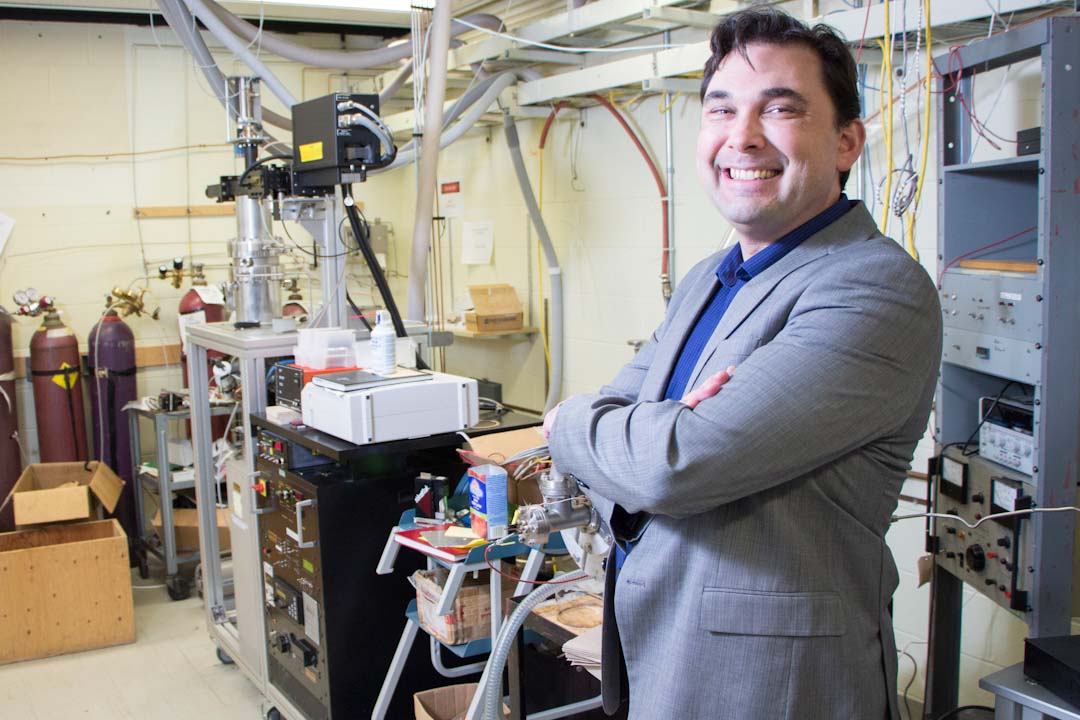
USask physicist teams up with U.K. partners in world-first program of quantum technologies
SASKATOON – As part of a new U.K.-Canada collaboration, a University of Saskatchewan (USask) quantum physics team will develop a highly sensitive and precise sensor for measuring magnetic fields, a technology of potential benefit for geological prospecting, medicine, and quantum computers.
By USask Research Profile and ImpactUSask physicist Michael Bradley is one of eight winners of the U.K.-Canada Quantum Technologies Competition aimed at accelerating promising quantum technologies for real-world applications in areas such as health care, secure communications, and financial services.
Bradley’s quantum sensor or “magnetometer” for detecting magnetic fields would be more compact, cheaper and easier for geophysical companies to use in taking measurements of ore bodies in remote environments than the bulky liquid-helium-cooled devices currently available. As well, the measurements can be taken without the bulky cryogenic cooling apparatus needed for other techniques.
Bradley’s technique relies on the wavelike quantum mechanical properties of electrons to make higher precision measurements than are possible using classical approaches. The technology has been demonstrated in the lab, but there is no commercial product on the market.
“We aim to design, build and demonstrate a quantum magnetometer that will be a powerful way to measure small magnetic fields,” said Bradley. “In three years, we want to be able to place in the hands of geophysicists a Rubik’s Cube-sized box containing this new measurement tool for precisely detecting the magnetic field signatures of various rock formations.”
The competition is run jointly by the U.K. Research and Innovation (UKRI) and Natural Sciences and Engineering Research Council of Canada (NSERC). Bradley’s $90,000 project involves academic partner University of Nottingham (Prof. Mark Fromhold) and industrial partners M-Squared Lasers Limited in the U.K., and Saskatoon-based Dias Geophysical Ltd.
At the core of the compact magnetometer is diamond. That’s because some diamonds have a naturally occurring atomic impurity (a nitrogen-vacancy centre) in which energy levels of trapped electrons are extremely sensitive to a nearby magnetic field. An optical signal from the electrons excited by the magnetic field is detected by a laser. In their lab, Bradley’s team has demonstrated the capability to grow high-quality synthetic diamond chips for use in the new instrument.
Another potential application of the new technology could be in neuroscience, Bradley said. For instance, helmets studded with the diamond magnetometers could be used to precisely monitor brain activity. The technology might also be developed for doctors to detect certain bacteria that contain magnetic iron oxide crystals.
The new magnetometer would also provide improved sensor technology for environmental monitoring and could have applications in developing quantum computers which would be much faster at processing than even the largest standard ones.
Bradley is a member of the USask Centre for Quantum Topology and its Applications which involves researchers from mathematics, physics, computing and chemistry collaborating on work related to quantum materials.
The U.K.-Canada competition follows a 2017 agreement between the two nations to share quantum expertise through academic and business collaborations. More information on the initiative is available here: https://www.nserc-crsng.gc.ca/Media-Media/NewsDetail-DetailNouvelles_eng.asp?ID=1195 and https://www.nserc-crsng.gc.ca/NSERC-CRSNG/FundingDecisions-DecisionsFinancement/2020/UKRI_eng.asp
-30-
For more information, contact:
Victoria Dinh
USask Media Relations
306-966-5487
victoria.dinh@usask.ca

